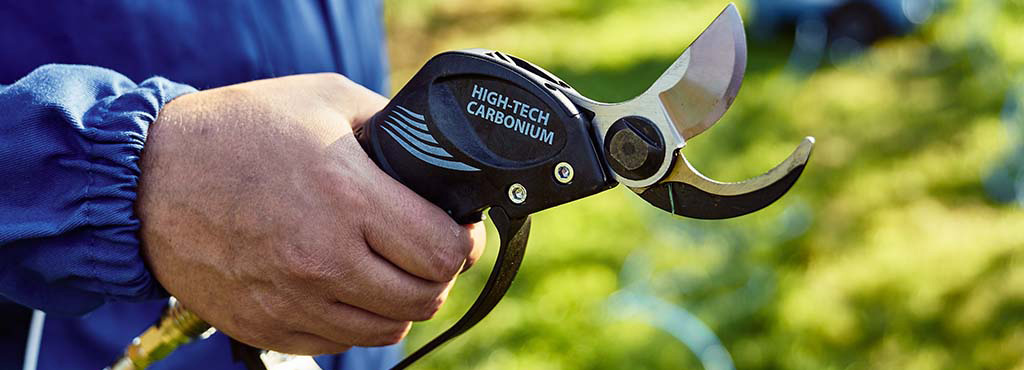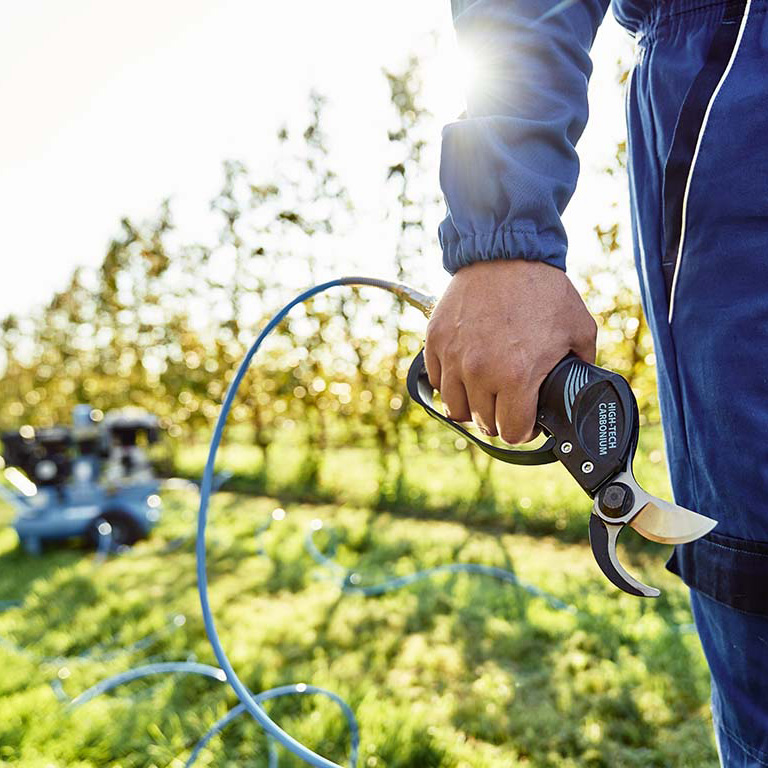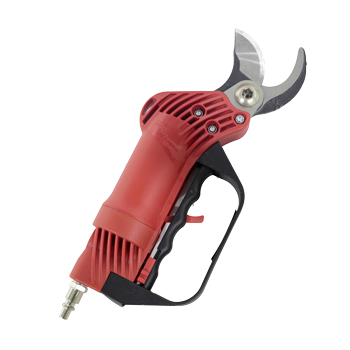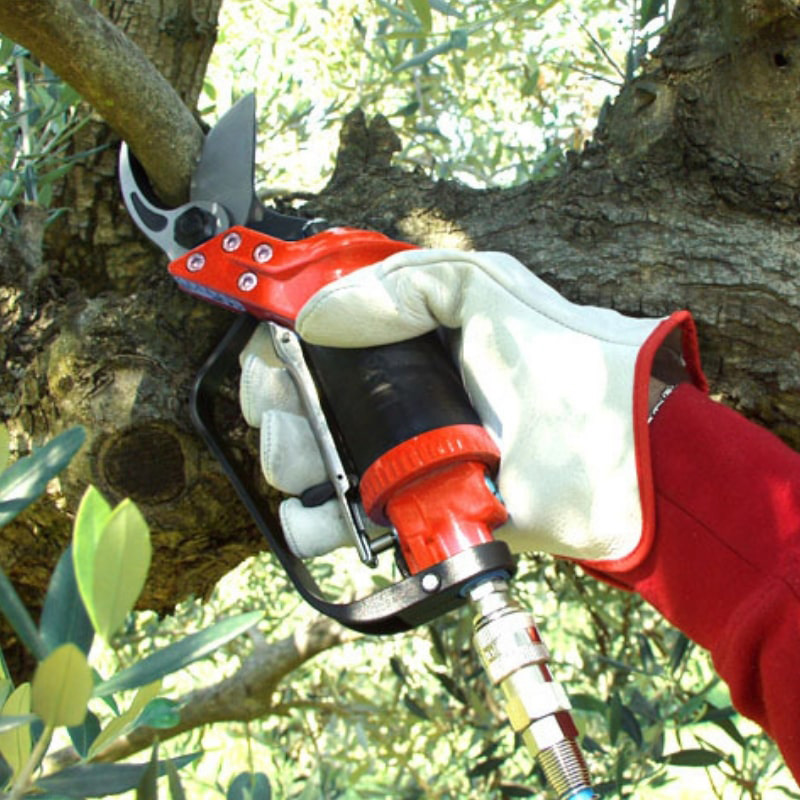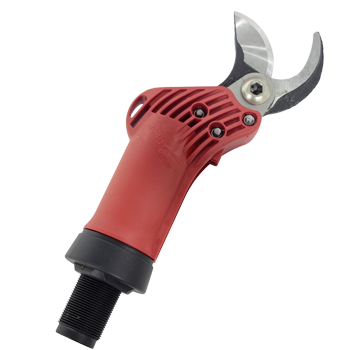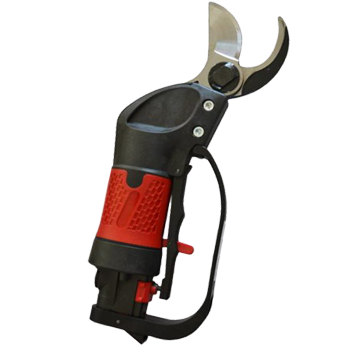A comprehensive guide to purchasing pneumatic pruning shears, a version of pruning shears intended for intensive and professional use.
The Complete Guide to help you choose the Best Pneumatic Pruning Shears
by the Real Experts of Pruning Equipment
CONTENTS
1. Introduction
Pruning is considered by many to be an art that improves plant growth, optimises the light absorption and prevents diseases. For this reason, professional pruning operations require the most appropriate equipment, especially when removing excess branches from very delicate types of plants, such as olive trees or vines.
As a response to the need for maximum cutting efficiency, the market has recently experienced a progressive spread of mechanised pruning shears. While electric battery-powered pruning shears come in a heterogeneous range of models with multiple performance levels, pneumatic pruning shears are designed for intensive use and are intended for professionals.
Pneumatic pruning shears, are not only much more functional than ordinary manual pruning shears, but are also the ideal solution for speeding up the pruning of the most robust branches in very large crops.
2. What are pneumatic pruning shears?
Pneumatic pruning shears are designed to bring a major improvement on traditional pruning shears. Where electric pruning shears are powered by a battery, pneumatic shears need to be connected by means of a hose with quick joints to an air compressor or petrol engine-driven air compressor.
To guarantee correct supply of the pruning shears, the operating pressure of the compressed air must never be less than 10 bar. In addition, it should be remembered that instead of the common direct male coupling, the pruning shears should be connected to the air compressor via a swivel fitting, in order to prevent the hoses from curling during work and the material on the coupling ends from being damaged.
Moreover, as already mentioned, pneumatic pruning shears are especially designed for professionals. Compressed air works less quickly than a rechargeable battery and is therefore not ideal for occasional, small-scale pruning jobs.
Pneumatic pruning shears are ideally suited for cutting branches up to 5 cm thick, as is often the case with fruit trees. Due to the fact that they are operated by an air compressor that is always running, these tools generate much more noise that battery-powered models. However, the use of compressed air makes these pruning shears extremely precise and efficient.
Pneumatic pruning shears are fitted with steel blades that can cut sharply through all types of wood. Just like electric pruning shears, pneumatic models can be equipped with a direct grip or can be suitable for application on practical fixed or telescopic extension poles.
The same family of pneumatic pruning shears also encompasses branch loppers. Basically, they are an upgraded version of the pneumatic pruning shears, designed to ease the pruning of thicker and more resistant branches.
3. The advantages of pneumatic pruning shears
The advantages of using pneumatic pruning shears cannot be achieved with conventional manual pruning shears. Which essential benefits make pneumatic pruning shears an irreplaceable tool for professional pruning?
- A high degree of productivity, due to a significant reduction in working time.
- The unmatched lightness of the tool (400/700 g), thanks to the absence of the weight which normally derives from mounting a battery on the appliance.
- The opportunity to make fast, precise cuts quickly and effectively on any type of wood.
- No fatigue during pruning. This is very important, as carpal tunnel syndrome is one of the main conditions a professional pruner suffers from. The pain and numbness of the hand and wrist caused by the constant pressure required by conventional pruning shears will no longer be a concern thanks to the comfortable trigger fitted on these tools.
Pneumatic pruning shears undoubtedly belong to a niche market compared to battery-powered models. Therefore, in spite of all the advantages outlined above, some aspects need to be carefully weighed up as they might make this equipment an unsuitable choice for a large share of users.
- The need for a petrol engine-driven air compressor or an electric air compressor, which are essential machines for operating the pneumatic pruning shears.
- The presence of the hose with quick joints for transporting the compressed air, which may be uncomfortable for those used to greater freedom of movement during work.
- The unavoidable noise emissions produced by the electric air compressor or petrol engine-driven air compressor during pruning operations.
4. What are the main features to consider when purchasing pneumatic pruning shears?
The category of pneumatic pruning shears, being mainly intended for professional applications, features models characterised by greater consistency than battery-powered ones. Nonetheless, they do not lack peculiarities that can set them apart and affect the final choice of a potential customer. It is therefore necessary, before moving on with the purchase, to take into consideration some elements that can serve as a guidelines for the product choice.
- MANUAL USE OR ON EXTENSION POLE: a major difference in the category of pneumatic pruning shears stems from two possible tool configurations.
The models for manual use are the most suitable solution if the branches to be pruned are at easily accessible heights. The ability to hold the shears directly in one’s own hand is a significant advantage for efficiently carrying out all the pruning work in vineyards or orchards where trees are generally very small.
Pneumatic pruning shears on extension pole, on the other hand, can be an obvious choice if the shrubs to be cut are too high. In addition, many models are equipped with a telescopic pole, which allows to set the working height of the blades.
A considerable range of pneumatic pruning shears on the market supports dual configuration, which enables the tool handle to be modified as required.
- DIAMETER OF THE BRANCHES: in order to choose the most suitable pneumatic pruning shears for your needs, it is essential to pay attention to the thickness of the branches to be cut. As the diameter increases, it will be advisable to use pruning shears with suitable power.
Generally speaking, for pruning branches no thicker than 35 mm, it will be sufficient to use semi-professional pneumatic pruning shears. When cutting shrubs between 40 and 50 mm, it is advisable to use a pair of fully professional pneumatic pruning shears.
- CUTTING CAPACITY: pneumatic pruning shears with a direct grip and those on extension pole usually have different cutting capacities.
Due to their natural shape and height, models on extension pole can not be operated with the same precision as a manual handle. However, pruning shears on extension pole, make up for this with optimised cutting power that ensures clean, quick cuts on thick branches up to 35 mm.
Conversely, pneumatic pruning shears for manual use, although generally less powerful than those equipped with an extension pole, allow to work with larger branch diameters of up to 50 mm. In such cases, the pruning shears will be categorised as real branch loppers.
5. Major brands
Before moving on with the purchase of pneumatic pruning shears, it is advisable to take a look at the most professional and well-known brands in the world of pruning equipment. Choosing a reliable manufacturer gives the user the certainty of a safe and quality-certified tool to carry out work in a smooth and trouble-free manner.
The recommended brands, for both hobby and heavy-duty models, are: Paterlini, Zanon, Campagnola and M.A.I.BO.
The following table shows the most representative models of electric battery-powered pruning shears produced by the above-mentioned manufacturers.



